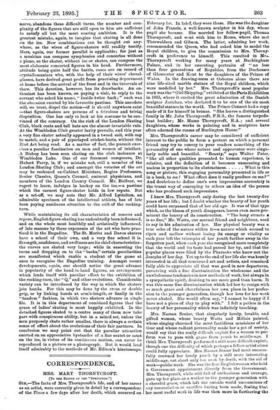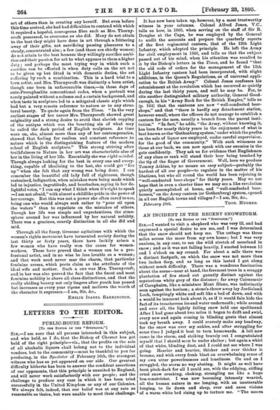CORRESPONDENCE.
MRS. MARY THORNYCROFT.
[TO TIM EDITOR OF THE "SrICCIATOR,1 in,—The facts of Mrs. Thornycroft's life, and of her career as an artist, were correctly given in detail by a correspondent of the Times a few days after her death, which occurred on
February 1st. In brief, they were these. She was the daughter of John Francis, a well-known sculptor in his day, whose pupil she became. She married her fellow-pupil, Thomas Thornycroft, and went with him to Rome, where she met Thorwaldsen and Gibson. The latter, admiring her work, recommended the Queen, who had asked him to model the Royal children, to give the commission to Mrs. Thorny- croft in preference to himself. This resulted in Mr.,. Thornycroft working for many years at Buckingham Palace, and in her executing portraits of "no leas than four generations of Royalties, from the Duchesses of Gloucester and Kent to the daughters of the Prince of Wales. In the drawing-room at Osborne alone there are nine life-sized marble statues of the Royal children, which were modelled by her." Mrs. Thornycroft's most popular work was the "Girl Skipping," exhibited at the Paris Exhibition in 1855, where it excited the great admiration of the Danish sculptor Jerichau, who declared it to be one of the six most beautiful statues in the world. The Prince Consort had a copy made of it for himself in bronze. "She leaves a distinguished family in Mr. John Thornycroft, FRS., the famous torpedo- boat builder ; Mr. Hamo Thornycroft, R.A.; and several daughters, whose works in painting and in sculpture have often adorned the rooms of Burlington House."
Mrs. Thornycroft's career may be considered of sufficient interest to the publics to form a pretext on which a personal friend may try to convey to your readers something of the personality of one whose nature and appearance were singu- larly noble and beautiful. "Beauty," says Walter Pater, "like all other qualities presented to human experience, is relative, and the definition of it becomes unmeaning and
useless in proportion to its abstractness What is this song or picture, this engaging personality presented in life or in a book, to me? What effect does it really produce on me ? " And doubtless to define one's own impressions accurately is the truest way of conveaing to others an idea of the person who has produced such impressions.
I knew Mrs. Thornycroft only during the last twenty-five years of her life ; bat I doubt whether the beauty of her youth could have surpassed that of her old age. It was of that type which, as the bloom of youth disappears, leaves even more pro- minent the beauty of its construction. "The bony structu a is so fine," Mr. Watts, our mutual friend and neighbour, used to say in his admiration of her. Her physical beauty was a true echo of the nature within it—a nature which seemed to ripen and mellow without losing its energy or vitality as each year left the triumphs of her youth further away in the forgotten past, when each year she recognised more completely that the world and its taste had passed her by, and that the popular places were filled by the Pharaohs who knew not the Josephs of her day. Yet up to the end of her life she was keenly interested in all that concerned art and artists, and remained fully able to appreciate all that was good in new departures, perceiving with a fine discrimination the wholesome and the unwholesome tendencies in new methods of work, but always in a sympathetic spirit, desiring to see more good than harm. It was this same fine discrimination which led her to resign with so much grace and cheerfulness her own place in her profes- sion to the younger generation, though her love for her work never abated. She would often say, "I cannot be happy if I have not a piece of clay to play with." I felt a pathos in the beauty of her personality which was infinitely touching.
Mrs. Nassau Senior, that singularly lovely, lovable, and gifted woman, whose beauty Watts and Millais painted, whose singing charmed the most fastidious musicians of her time and whose radiant personality made her a pet of society, would say that the really difficult exploit for a woman to per- form was to pass -with grace from youth to middle-age.I think Mrs. Thornycroft performed a still more difficult exploit, though one the difficulty of which perhaps a fellow-artist alone could fully appreciate. Mrs. Nassau Senior had most success- fully crowned her lovely youth by a still more interesting middle-age, cut short only too soon by death, with the aid of work—public work. She was the first Englishwoman who held a Government appointment directly from the Government. Mrs. Thornycroft, while still full of enthusiasm and courage, gave up her place as a worker to the younger generation with a cheerful grace, which left the outside world unconscious of any renunciation or sacrifice having been made, feeling that her most useful work in life was then more in furthering the
art of others than in creating any herself. Bat even before this time arrived, she had had difficulties to contend with which it required a hopeful, courageous fibre such as Mrs. Thorny- croft possessed, to overcome as she did. Many do not attain to the best they might have done in art through a frittering away of their gifts, not sacrificing passing pleasures to a steady, concentrated aim ; a few (and these are chiefly women) do not attain to the best because they willingly sacrifice ambi- tion and their passion for art to what appears to them a higher duty ; and perhaps the most trying way in which such a sacrifice can be effected is when duty calls on the art not to he given up bat fitted in with domestic duties, the art snffuring by such a combination. This is a hard trial to a born artist, and Mrs. Thornycroft was distinctly a born artist,
though one born in unfavourable times,—in those days of ante-Preraphaelite conventional codes, when a portrait was rarely painted without a column and a curtain background, and when taste in sculpture led to a mitigated classic style which had but a very remote reference to nature or to any struc- tural beauty. To quote again from the Times. "In the very earliest stages of her career Mrs. Thornycroft showed great originality and a strong desire to avoid that slavish copying of the antique which was the besetting sin of what may be called the dark period of English sculpture. As time wore on, she, almost more than any of her contemporaries, showed that feeling for realism and constant reference ,to nature which is the distinguishing feature of the modern school of English sculpture." This strong striving after truthfulness to Nature in her art was characteristic also of her in the living of her life. Essentially she was right-minded. Though always looking for the best in every one and every- thing, capable of idealising to the last, she could get "fire up" when she felt that any wrong was being done. I can remember the beautiful old lady fall of righteous, though restrained, indignation, when mistakes were being made which led to injustice, ingratitude, and heartaches, saying in her de- lightful voice, "I can say what I think when it's right to speak
am not afraid," with almost a childlike pride in the power of her courage. But this was not a power she often cared to use, being one who would always seek rather to "pour oil upon the waters" than to expatiate on the mistakes of others. Though her life was simple and unpretentious, the atmo- sphere around her was influenced by her natural nobility. There was a gracious, courtly distinction in all she did and said.
Through all the fussy, tiresome agitations with which the women's rights movement have tormented society during the last thirty or forty years, there have luckily arisen a few women who have really won the cause for women- workers. These have proved that a woman can be a pro- fessional artist, and in no wise be less lovable as a woman ; and that work need never mar the charm, that particular feminine aroma, which poets claim as the attribute of the ideal wife and mother. Such a one was Mrs. Thornycroft, and in her was also proved the fact that the finest and most feminine nobility is above all class-distinctions, and that the really ahiding beauty not only lingers after youth has passed but increases as every year ripens and mellows the worth of the character it expresses.—I am, Sir, &c., EatiatE ISABEL BARRINGTON.



































 Previous page
Previous page